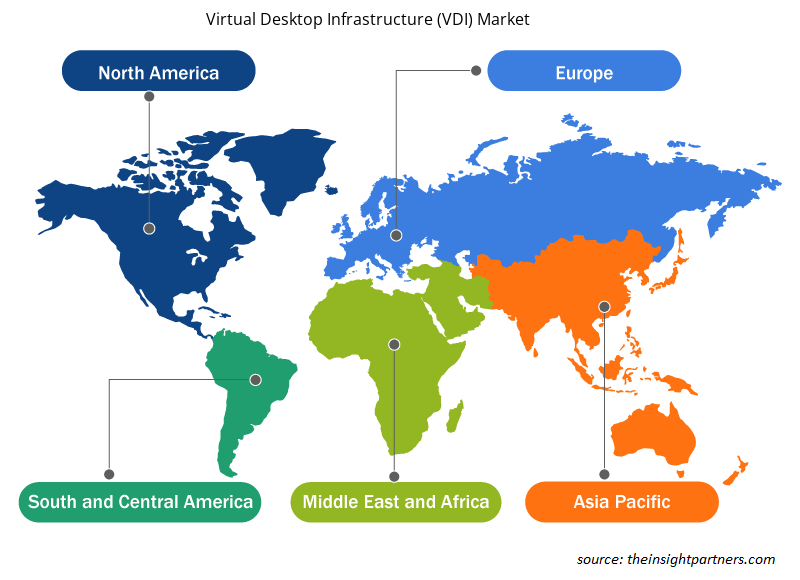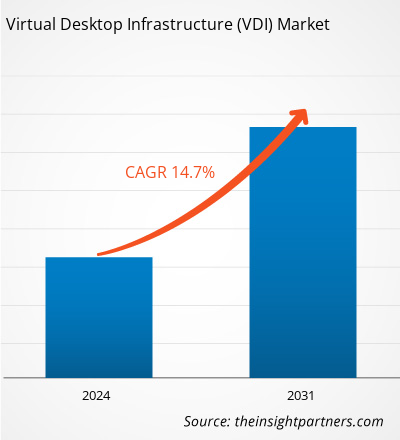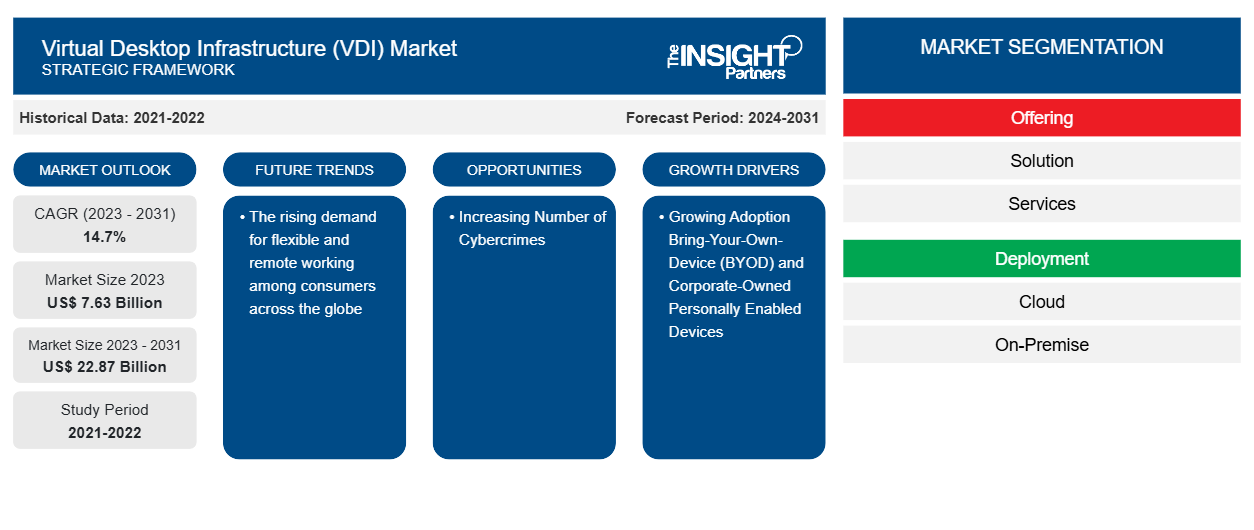من المتوقع أن يصل حجم سوق البنية التحتية لسطح المكتب الافتراضي (VDI) إلى 22.87 مليار دولار أمريكي بحلول عام 2031 من 7.63 مليار دولار أمريكي في عام 2023. ومن المتوقع أن يسجل السوق معدل نمو سنوي مركب بنسبة 14.7٪ في الفترة 2023-2031. ومن المرجح أن يظل الطلب المتزايد على العمل المرن والعمل عن بُعد بين المستهلكين في جميع أنحاء العالم اتجاهًا رئيسيًا في سوق البنية التحتية لسطح المكتب الافتراضي (VDI).
تحليل سوق البنية التحتية لسطح المكتب الافتراضي (VDI)
ينمو سوق البنية التحتية لسطح المكتب الافتراضي (VDI) بوتيرة سريعة بسبب التبني المتزايد لأجهزة BYOD والأجهزة المملوكة للشركات والممكّنة شخصيًا والمخاوف الأمنية المتزايدة بين المستهلكين. يتوسع السوق بشكل مطرد، مدفوعًا بتوسع الشركات الصغيرة والمتوسطة واللوائح الحكومية الصارمة للتدابير الأمنية. علاوة على ذلك، فإن العدد المتزايد من الجرائم الإلكترونية ودمج التقنيات المتقدمة مثل الذكاء الاصطناعي والحوسبة السحابية وإنترنت الأشياء في البنية التحتية لسطح المكتب الافتراضي توفر فرصًا مربحة لنمو السوق.
نظرة عامة على سوق البنية التحتية لسطح المكتب الافتراضي (VDI)
غالبًا ما يتم بناء حلول البنية الأساسية لسطح المكتب الافتراضي (VDI) على بنية العميل/الخادم مع نظام التشغيل والتطبيقات الخاصة بالمؤسسة. تعمل حلول VDI على خادم في السحابة أو مركز بيانات. في هذه البنية، تتم جميع التفاعلات مع المستخدمين على جهاز محلي من اختيار المستخدم. تعد VDI أيضًا مكونًا مهمًا لأماكن العمل الرقمية، نظرًا لاعتماد أحمال عمل سطح المكتب الافتراضي الحديثة على تقنية البنية الأساسية لسطح المكتب الافتراضي، والتي تعمل على آلات افتراضية إما في مراكز البيانات المحلية أو السحابية العامة. يؤدي هذا إلى زيادة استخدام البنية الأساسية لسطح المكتب الافتراضي بين الشركات لتبسيط عمل الموظفين مما يغذي السوق.
قم بتخصيص هذا التقرير ليناسب متطلباتك
ستحصل على تخصيص لأي تقرير - مجانًا - بما في ذلك أجزاء من هذا التقرير، أو تحليل على مستوى الدولة، وحزمة بيانات Excel، بالإضافة إلى الاستفادة من العروض والخصومات الرائعة للشركات الناشئة والجامعات
-
احصل على أهم اتجاهات السوق الرئيسية لهذا التقرير.ستتضمن هذه العينة المجانية تحليلاً للبيانات، بدءًا من اتجاهات السوق وحتى التقديرات والتوقعات.
محركات وفرص سوق البنية التحتية لسطح المكتب الافتراضي (VDI)
إن التبني المتزايد لمفهوم "إحضار جهازك الخاص" (BYOD) والأجهزة المملوكة للشركات والمدعومة شخصيًا هو المحرك للسوق
يؤدي توسع القوى العاملة المتنقلة إلى زيادة الطلب على البنية الأساسية لسطح المكتب الافتراضي لتحسين إنتاجية الشركات. تستفيد البنية الأساسية لسطح المكتب الافتراضي من قدرة الموظفين على الوصول إلى صور سطح المكتب الافتراضي باستخدام هواتفهم الذكية وأجهزة الكمبيوتر المحمولة والهواتف المحمولة. إن التبني المتزايد لأجهزة BYOD والأجهزة المملوكة للشركات والممكنة بشكل فردي يدفع الطلب على سوق البنية الأساسية لسطح المكتب الافتراضي في صناعة تكنولوجيا المعلومات والاتصالات. تعمل الشركات تحت ضغط لتبني التقنيات الافتراضية المتقدمة المنسوبة إلى استهلاك تكنولوجيا المعلومات والتنقل وأجهزة BYOD. وهذا يزيد من تركيزها على تطوير البنية الأساسية المتقدمة لسطح المكتب الافتراضي لإدارة استهلاك تكنولوجيا المعلومات وتكاليفها. ومع ذلك، أصبحت تقنية المحاكاة الافتراضية لسطح المكتب تحظى بشعبية متزايدة بسبب تعزيز الأمان والامتثال والحوكمة، وهو ما من المتوقع أن يغذي السوق خلال فترة التنبؤ.
تزايد عدد الجرائم الإلكترونية – فرصة في سوق البنية التحتية لسطح المكتب الافتراضي (VDI)
أدى التقدم في تكنولوجيا المحاكاة الافتراضية إلى زيادة استخدام البنية التحتية لسطح المكتب الافتراضي بين الشركات لإعطاء الأولوية للأمن والامتثال ضد خروقات البيانات والهجمات الإلكترونية. إن العدد المتزايد من الجرائم الإلكترونية في جميع أنحاء العالم يخلق فرصًا في السوق. على سبيل المثال، وفقًا لتقرير BioCatch's Digital Banking Fraud Trends in North America الصادر في ديسمبر 2023، ارتفعت معدلات الخدمات المصرفية عبر الهاتف المحمول إلى 73٪ في عام 2023. وقد تسبب هذا بدوره في زيادة كبيرة في عمليات الاحتيال التي يتم تنفيذها عبر الأجهزة المحمولة، حيث ارتفعت من 47٪ في عام 2022 إلى 61٪ في عام 2023. وهذا يزيد من اعتماد البنية التحتية لسطح المكتب الافتراضي بين المستخدمين لتقليل المخاطر وحماية بياناتهم ومعلوماتهم من الهجمات الإلكترونية.
تقرير تحليل تجزئة سوق البنية التحتية لسطح المكتب الافتراضي (VDI)
إن القطاعات الرئيسية التي ساهمت في اشتقاق تحليل سوق البنية التحتية لسطح المكتب الافتراضي (VDI) هي العرض والنشر وحجم المؤسسة والمستخدم النهائي.
- بناءً على العرض، ينقسم سوق البنية التحتية لسطح المكتب الافتراضي (VDI) إلى الحلول والخدمات. احتل قطاع الحلول حصة سوقية أكبر في عام 2023.
- من حيث النشر، يتم تصنيف السوق إلى سحابي ومحلي. احتل قطاع السحابة حصة سوقية أكبر في عام 2023.
- على أساس حجم المؤسسة، يتم تقسيم سوق البنية التحتية لسطح المكتب الافتراضي (VDI) إلى الشركات الصغيرة والمتوسطة الحجم والشركات الكبيرة. احتلت شريحة الشركات الصغيرة والمتوسطة حصة سوقية أكبر في عام 2023.
- من حيث المستخدم النهائي، يتم تقسيم سوق البنية التحتية لسطح المكتب الافتراضي (VDI) إلى تكنولوجيا المعلومات والاتصالات والحكومة والرعاية الصحية والخدمات المصرفية والمالية والتأمين والتعليم وتجارة التجزئة والتصنيع والمستخدمين النهائيين الآخرين. احتل قطاع تكنولوجيا المعلومات والاتصالات حصة سوقية أكبر في عام 2023.
تحليل حصة سوق البنية التحتية لسطح المكتب الافتراضي (VDI) حسب المنطقة الجغرافية
ينقسم النطاق الجغرافي لتقرير سوق البنية التحتية لسطح المكتب الافتراضي (VDI) بشكل أساسي إلى خمس مناطق: أمريكا الشمالية، ومنطقة آسيا والمحيط الهادئ، وأوروبا، والشرق الأوسط وأفريقيا، وأمريكا الجنوبية/أمريكا الجنوبية والوسطى.
من حيث الإيرادات، استحوذت أمريكا الشمالية على أكبر حصة في سوق البنية التحتية لسطح المكتب الافتراضي (VDI)، وذلك بسبب التبني المتزايد لتكنولوجيا الحوسبة السحابية بين الشركات. إن الطلب المتزايد على البنية التحتية لسطح المكتب الافتراضي من صناعات تكنولوجيا المعلومات والاتصالات والألعاب والإلكترونيات الاستهلاكية والترفيه لتحسين العمل التعاوني من خلال تعزيز الكفاءة التشغيلية هو المحرك الرئيسي للسوق. علاوة على ذلك، فإن تفضيل الموظفين للعمل المرن والعمل عن بُعد يعزز سوق البنية التحتية لسطح المكتب الافتراضي (VDI) في المستقبل القريب.
رؤى إقليمية حول سوق البنية التحتية لسطح المكتب الافتراضي (VDI)
لقد قام المحللون في Insight Partners بشرح الاتجاهات والعوامل الإقليمية المؤثرة على سوق البنية التحتية لسطح المكتب الافتراضي (VDI) طوال فترة التوقعات بشكل شامل. يناقش هذا القسم أيضًا قطاعات سوق البنية التحتية لسطح المكتب الافتراضي (VDI) والجغرافيا في جميع أنحاء أمريكا الشمالية وأوروبا ومنطقة آسيا والمحيط الهادئ والشرق الأوسط وأفريقيا وأمريكا الجنوبية والوسطى.

- احصل على البيانات الإقليمية المحددة لسوق البنية التحتية لسطح المكتب الافتراضي (VDI)
نطاق تقرير سوق البنية التحتية لسطح المكتب الافتراضي (VDI)
| سمة التقرير | تفاصيل |
|---|---|
| حجم السوق في عام 2023 | 7.63 مليار دولار أمريكي |
| حجم السوق بحلول عام 2031 | 22.87 مليار دولار أمريكي |
| معدل النمو السنوي المركب العالمي (2023 - 2031) | 14.7% |
| البيانات التاريخية | 2021-2022 |
| فترة التنبؤ | 2024-2031 |
| القطاعات المغطاة |
عن طريق العرض
|
| المناطق والدول المغطاة |
أمريكا الشمالية
|
| قادة السوق وملفات تعريف الشركات الرئيسية |
|
كثافة اللاعبين في سوق البنية التحتية لسطح المكتب الافتراضي (VDI): فهم تأثيرها على ديناميكيات الأعمال
يشهد سوق البنية التحتية لسطح المكتب الافتراضي (VDI) نموًا سريعًا، مدفوعًا بالطلب المتزايد من المستخدم النهائي بسبب عوامل مثل تفضيلات المستهلكين المتطورة والتقدم التكنولوجي والوعي المتزايد بفوائد المنتج. ومع ارتفاع الطلب، تعمل الشركات على توسيع عروضها والابتكار لتلبية احتياجات المستهلكين والاستفادة من الاتجاهات الناشئة، مما يؤدي إلى زيادة نمو السوق.
تشير كثافة اللاعبين في السوق إلى توزيع الشركات أو المؤسسات العاملة في سوق أو صناعة معينة. وهي تشير إلى عدد المنافسين (اللاعبين في السوق) الموجودين في مساحة سوق معينة نسبة إلى حجمها أو قيمتها السوقية الإجمالية.
الشركات الرئيسية العاملة في سوق البنية التحتية لسطح المكتب الافتراضي (VDI) هي:
- أمازون دوت كوم، المحدودة
- شركة سيسكو سيستمز
- شركة آي بي إم
- شركة مايكروسوفت
- شركة VMware
- فوجيتسو المحدودة
إخلاء المسؤولية : الشركات المذكورة أعلاه ليست مرتبة بأي ترتيب معين.

- احصل على نظرة عامة على أهم اللاعبين الرئيسيين في سوق البنية التحتية لسطح المكتب الافتراضي (VDI)
أخبار سوق البنية التحتية لسطح المكتب الافتراضي (VDI) والتطورات الأخيرة
يتم تقييم سوق البنية التحتية لسطح المكتب الافتراضي (VDI) من خلال جمع البيانات النوعية والكمية بعد البحث الأولي والثانوي، والذي يتضمن منشورات الشركات المهمة وبيانات الجمعيات وقواعد البيانات. فيما يلي قائمة بالتطورات في سوق البنية التحتية لسطح المكتب الافتراضي (VDI) والاستراتيجيات:
- في أغسطس 2023، أعلنت شركة VMware, Inc. عن تكاملات الذكاء الاصطناعي الحديثة مع منصة Anywhere Workspace التي تعمل تلقائيًا على تحسين تجربة الموظفين، ودفع حالات استخدام جديدة لإدارة الثغرات الأمنية، وتبسيط إدارة دورة حياة التطبيق. VMware Anywhere Workspace هي منصة العمل الهجينة الوحيدة التي تدمج تجربة الموظف الرقمية (DEX) والبنية الأساسية والتطبيقات لسطح المكتب الافتراضي (VDI وDaaS) وإدارة نقطة النهاية الموحدة (UEM) والأمان لتمكين مساحة عمل سلسة وآمنة على أي جهاز أو موقع. (المصدر: VMware, Inc.، بيان صحفي، 2023)
- في سبتمبر 2022، أعلنت شركة Amazon.com, Inc عن Amazon WorkSpaces Core، وهي خدمة جديدة للبنية الأساسية لسطح المكتب الافتراضي (VDI) تتم إدارتها بالكامل وتجمع بين الأمان والموثوقية العالمية وكفاءة التكلفة التي توفرها AWS وحلول إدارة VDI الحالية. (المصدر: Amazon.com, Inc، بيان صحفي، 2023)
تقرير سوق البنية التحتية لسطح المكتب الافتراضي (VDI) والتغطية والنتائج المتوقعة
يوفر تقرير "حجم سوق البنية التحتية لسطح المكتب الافتراضي (VDI) والتوقعات (2021-2031)" تحليلاً مفصلاً للسوق يغطي المجالات التالية:
- حجم السوق والتوقعات على المستويات العالمية والإقليمية والوطنية لجميع قطاعات السوق الرئيسية التي يغطيها النطاق
- ديناميكيات السوق مثل المحركات والقيود والفرص الرئيسية
- الاتجاهات المستقبلية الرئيسية
- تحليل مفصل لقوى PEST/Porter الخمس وSWOT
- تحليل السوق العالمي والإقليمي الذي يغطي اتجاهات السوق الرئيسية واللاعبين الرئيسيين واللوائح والتطورات الأخيرة في السوق
- تحليل المشهد الصناعي والمنافسة الذي يغطي تركيز السوق، وتحليل خريطة الحرارة، واللاعبين البارزين، والتطورات الأخيرة
- ملفات تعريف الشركة التفصيلية
- التحليل التاريخي (سنتان)، سنة الأساس، التوقعات (7 سنوات) مع معدل النمو السنوي المركب
- تحليل PEST و SWOT
- حجم السوق والقيمة / الحجم - عالمي، إقليمي، بلد
- الصناعة والمنافسة
- مجموعة بيانات إكسل
التقارير الحديثة
شهادات العملاء
سبب الشراء
- اتخاذ قرارات مدروسة
- فهم ديناميكيات السوق
- تحليل المنافسة
- رؤى العملاء
- توقعات السوق
- تخفيف المخاطر
- التخطيط الاستراتيجي
- مبررات الاستثمار
- تحديد الأسواق الناشئة
- تحسين استراتيجيات التسويق
- تعزيز الكفاءة التشغيلية
- مواكبة التوجهات التنظيمية























 احصل على عينة مجانية ل - سوق البنية التحتية لسطح المكتب الافتراضي (VDI)
احصل على عينة مجانية ل - سوق البنية التحتية لسطح المكتب الافتراضي (VDI)